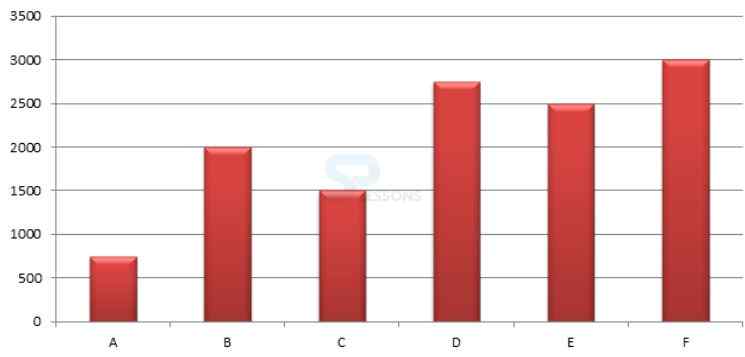 Introduction
Introduction
Data Interpretation is the ability to analyze, interpret and visualize the provided data to arrive at conclusions and to make inferences. Data Interpretation questions in the competitive exams is a test of analytical abilities. In the competitive exams, the Data Interpretation questions are grouped together and refer to the same table, graph or other data/visual presentation. The test takers are required to interpret or analyze the given data to answer the questions. In India, competitive exams related to employment in Banking, SSC, Insurance etc..have the Data Interpretation type of questions.
The article IBPS PO Data Analysis & Interpretation Quiz 1 provides Important Data Analysis & Interpretation Multiple choice questions useful to the candidates preparing IBPS PO Mains, Insurance and Bank Exams 2019.
 Quiz
Quiz
Directions (1-5): Study the following information carefully and answer the questions given below:
In a college there are 1400 students who are doing graduation in any one of the subjects, out of the five different subjects viz. Zoology, Botany, Mathematics, Physics and Statistics. The ratio of the number of boys and girls among them is 6:8.30% of the total girls are doing graduation in Zoology and 20% of the total girls are doing graduation in Statistics. The total number of students doing graduation in Botany is 220. 250 students are doing graduation in Mathematics. The ratio of the number of girls and the number of boys doing graduation in Statistics is 2:1.20% of the total number of boys are doing graduation in Botany. The ratio of the number of girls and that of boys doing graduation in Mathematics is 2:3. There are an equal number of boys and girls doing graduation in Physics. 290 students are doing graduation in Zoology.
1. What is the total number of students doing graduation in physics and Statistics together?
Required answer = 200 + 200 + 160 + 80 = 640
2. Answer - Option D
Explanation -
Required ratio = 150 : 100 = 3:2
3. Answer - Option A
Explanation -
Required difference = 100 - 50 = 50
4. Answer - Option D
Explanation -
Zoology and statistics
5. Answer - Option C
Explanation -
Required percentage = [latex]\frac {160}{200}[/latex] x 100 = 80%
- A. 510
B. 540
C. 640
D. 620
E. 660
- A. 1:2
B. 3:1
C. 3:4
D. 3:2
E. 2:1
- A. 50
B. 75
C. 60
D. 45
E. 55
- A. Statistics and Zoology
B. Zoology and Botany
C. Physics and Statistics
D. Zoology and Statistics
E. Physics and Zoology
- A. 76%
B. 75%
C. 80%
D. 81%
E. 78%
| Subjects | Girls | Boys |
|---|---|---|
| Zoology | 30 x 8 = 240 | 290 – 240 = 50 |
| Botany | 220 – 120 = 100 | 20 x 6 = 120 |
| Mathematics | [latex]\frac {2}{5}[/latex] x 250 = 100 | [latex]\frac {3}{5}[/latex] x 350 = 150 |
| Physics | 200 | 200 |
| Statistics | 20 x 8 = 160 | [latex]\frac {160}{2}[/latex] = 80 |
Directions (1 to 5): Following bar chart represents the number of people in 6 different villages (A, B, C, D, E and F) and the tabular column depicts the ratio of literate to illiterate people and percentage of male living in those villages.
1. If 40% of the female from village B is literate, then what is the percentage of male, who is illiterate from village B?
Number of people living in six villages
| Villages | Literate : Illiterate | % of male |
|---|---|---|
| A | 2 : 3 | 52 |
| B | 11 : 9 | 65 |
| C | 13 : 2 | 45 |
| D | 4 : 1 | 70 |
| E | 1 : 3 | 39 |
| F | 11 : 19 | 75 |
- A. 38%
B. 35%
C. 37%
D. Cannot be determined
E. None of these
- A. 55%
B. 53%
C. 51%
D. Cannot be determined
E. None of these
- A. 320:527
B. 527:330
C. 330:527
D. 527:320
E. None of these
- A. 1823
B. 1723
C. 1623
D. Cannot be determined
E. None of these
- A. 24.76%
B. 24.72%
C. 25.76%
D. 25.72%
E. None of these
Directions (1 to 5): Study the following the pie-chart and table carefully to answer the questions given below:
1. What is the average expenses of P?
The following pie-chart shows the distribution of the monthly family budget of a person.
The following table shows the further distribution (in percent) of the above-mentioned items among the five family members i.e P (the person himself), W (his wife), Rahul (son), Rohit (son), and Preeti (his daughter). His monthly family budget is Rs. 1,20,000| Name | Education | Food | Entertainment | Travelling | Other expenses |
|---|---|---|---|---|---|
| P | 10 | 30 | 10 | 40 | 20 |
| W | 15 | 25 | 30 | 10 | 25 |
| Rahul | 40 | 20 | 20 | 25 | 20 |
| Rohit | 25 | 15 | 25 | 10 | 10 |
| Preeti | 10 | 10 | 15 | 15 | 25 |
- A. Rs. 5620
B. Rs. 5644
C. Rs. 5640
D. Rs. 5460
E. Rs. 5480
- A. 33%
B. 31%
C. 34%
D. 37%
E. 35%
- A. 76.4%
B. 81.5%
C. 79.5%
D. 83.5%
E. 89.5%
- A. 1.3%
B. 0.9%
C. 2%
D. 2.2%
E. 2.5%
- A. 150%
B. 168%
C. 171%
D. 175%
E. 174%







